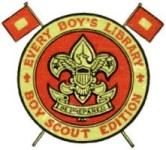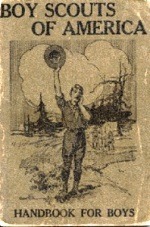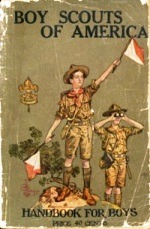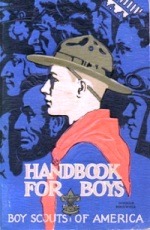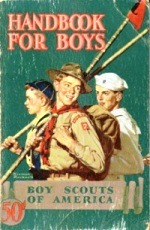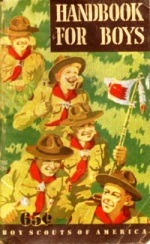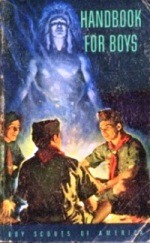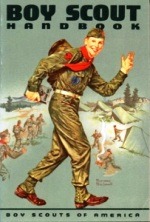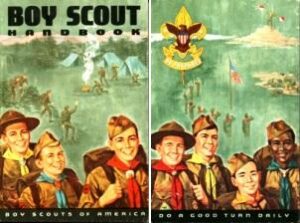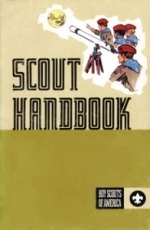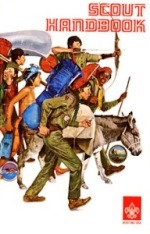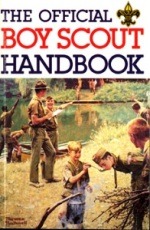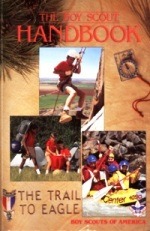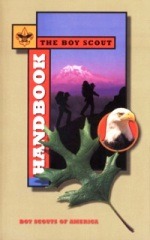The Call of the Wild: Character Building & the Boy Scout Handbook
Date:
16 May 2005 – 31 October 2005
Location: Dome Room, UVA Rotunda
Curated by: by William Ingram ’05
BSA Insignia — Every Boy’s Library Boy Scout Edition About two months before my 11th birthday, I first accompanied my friend Tim to a meeting of the Boy Scouts of America (BSA) Troop 24 in Norfolk, VA. I have great memories of my years as a Scout, especially the camping trips and stories told late at night around the campfires. As an adult, I remain interested in the Boy Scouts because of the way Scouting builds character in boys. I was not aware of the broader implications at the time, but while I was tramping through the Virginia woods with my backpack, my Boy Scout experience was molding me into an adult. The beliefs instilled in me by the Scout Oath and the Scout Law—honesty, loyalty and duty to my family and my community—resonate with me even now. The core of my Rotunda exhibition, titled “The Call of the Wild: Character Building and the Boy Scout Handbook“, is the relationship between the adventure of Scouting and the BSA’s commitment to teaching civic responsibility, which boys would not necessarily pursue without the lure of nature, brotherhood, and ceremony. The first edition of the BSA’s Handbook (1911–1914; 315,000 copies printed) The second edition of the Handbook (1914-1927; 2.6 million copies printed) Since its founding in 1910, the BSA has acknowledged the importance of providing its members with a comprehensive manual. The 11th and most recent edition of the Boy Scout Handbook was published in 1998; in all, nearly 40 million copies of the Handbook have been sold, placing it in third place for total sales among copyrighted books. Nearly every American boy has, at some time in his life, come into contact with the BSA’s manual. It is fascinating to compare the 11 editions of the Handbook: they reflect the values held by Americans over several generations. Copies of the 11 editions of the Handbook are chronologically displayed, clockwise around the Dome Room. Each alcove focuses on an individual theme, while the exhibition as a whole underscores my belief that the BSA’s nine decades of success are the result of the organization’s ability to balance character building and outdoor adventure. The third edition of the Handbook (1927–1940; 3.5 million copies printed) Ernest Thompson Seton was a noted naturalist, a best-selling writer, and a world-famous artist when, in 1910, he merged his Woodcraft Indians with the newly founded BSA. Seton became the organization’s Chief Scout, and the principal author of the first edition of the BSA’s Handbook. The fourth edition of the Handbook (1940–1948; 3.6 million copies printed) Seton did not get along well with James E. West, a Washington, DC lawyer who was appointed chief executive of the BSA in 1911. West held dramatically different views from Seton on how Scouting should develop. Seton was deeply committed to a BSA that would promote the ideal of living in harmony with the environment, but West believed that the BSA should concentrate more on building character and that the organization could be a prime training ground for the Army. In 1916, the headstrong West forced Seton out of the organization and removed his contributions from the second edition of the Handbook. The heavy-handed patriotism and loyalty taught to Boy Scouts in the years between the two World Wars is reflected in the third edition of the Handbook. For the cover illustration, Norman Rockwell offered his painting, Spirit of America. It featured the profile of a Scout against a blue background displaying the profiles of American heroes (Lincoln, Washington, Franklin, Teddy Roosevelt, a frontiersman, a Native American, &c.). Rockwell made a last-minute change to his design for the illustration by replacing the profile of a conquistador with the image of Charles Lindbergh, who had just made his famous solo flight to France. The first cover of the fifth edition Handbook (1948–1950; 1.3 million copies printed) The second cover of the fifth edition Handbook (1950–1959; 5.1 million copies printed) The cover of the fourth edition of the Handbook features Rockwell’s painting “The Scouting Trail”. His illustration, first used in a more elaborate form on the 1939 Boy Scout calendar, was simplified for use here. The Brown & Bigelow calendar company made an arrangement with the BSA to pay Rockwell for his paintings, use them on calendars, and then present the original art to the BSA together with permission to reproduce them for BSA-related purposes. Norman Rockwell illustrations have become as much a fixture of American culture as hot dogs, apple pie, and baseball. His work portrays the traditional BSA values of reverence, loyalty, and compassion, along with pride in country, heritage, and history.
Norman Rockwell did not create the cover of the fifth edition of the Handbook. Don Ross was responsible for this dull image—so dull, indeed, that it was quickly replaced. BSA artist Ross replaced his original cover for the fifth edition of the Handbook after less than two years with a much more interesting one, depicting three Scouts in overseas caps, sitting around a campfire with the smoke forming an Indian behind them. The sixth edition of the Handbook (1959–1965; 3.9 million copies printed) The fifth edition introduced the Scout Slogan, “Do a good turn daily.” It was the first to include the Conservation Pledge: “I give my pledge as an American to save and faithfully to defend from waste the natural resources of my Country—its soil and minerals, its forests, water and wildlife.” The seventh edition of the Handbook (1965–1972; 4.3 million copies printed) The sixth edition of the Handbook features the only Rockwell illustration made specifically for a Handbook cover; the artist did it in honor of the 50th anniversary of the founding of the Boy Scouts. Rockwell never quite finished his work on this illustration; the background was filled in by a staff artist. The sixth edition of the Handbook is the first to credit a single author, William “Green Bar Bill” Hillcourt. Dom Lupo’s cover illustration for the seventh edition of the Handbook is the first one to show the faces of Boy Scouts of multiple ethnicities— although they appear only on the back cover. The first cover of the eighth edition Handbook (1972–1976; 2.7 million copies printed) The second cover of the eithth edition Handbook (1976–1979; 1 million copies printed) The cover of the eighth edition of the Handbook was surprisingly bland—but its contents were not: it was radically different from both earlier and later editions of the manual. In service to the BSA’s new Improved Scouting Program of the 1970s, it promoted city-based activities and de-emphasized camping and woodcraft. Gone were signaling, map-making, canoeing, tracking, and fire by friction. In their place were sections on drug abuse, family finances, child care, community problems, and current events. During this period, BSA membership declined nationwide by 34%. After the disastrous 1970s attempts to reach the inner-city boy, William “Green Bar Bill” came out of retirement to write the ninth edition of the Handbook. Marking a return to traditional Scouting values, the ninth was the last edition to feature a Norman Rockwell illustration on its cover, a calendar painting originally used in 1970 called “Come and Get It”. The ninth edition of the Handbook (1979–1990; 4.4 million copies printed) The 10th edition of the Handbook (1990–1998; 3.2 million copies printed) The most striking difference between earlier editions of the Handbook and the 10th edition is the use of color photographs (as opposed to drawings), not only on the cover but also throughout the book. This edition is once again packed with information on camping, cooking, fire building, and other recreational Scouting activities. The current edition of the Handbook includes many recent changes in Scouting (some of them dictated by environmental concerns), including the use of GPS systems, water filters, and camp stoves. The joys of open campfires are de-emphasized, as is the Scout uniform; this is the first edition of the BSA Handbook not to show the uniform anywhere on its cover. The 11th edition of the Handbook (1998; 2.1 million copies thus far printed) This exhibition presents an informal look at the most successful youth organization in the country. It will probably be most enjoyed by former and current Boy Scouts, but I hope the exhibition will be interesting to everyone visiting the Rotunda. My experience with Scouting has been a positive one, and I have taken a cheerful approach to designing the show. Thank you for visiting!
